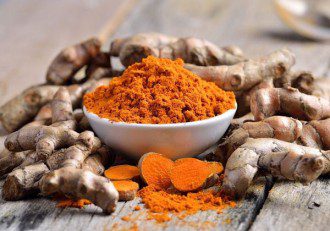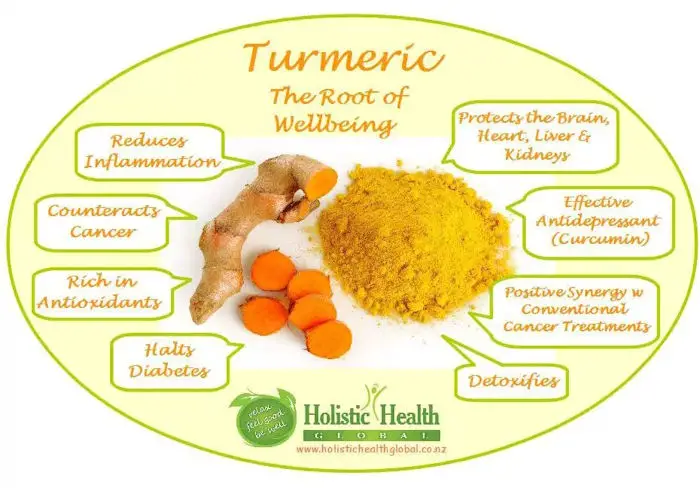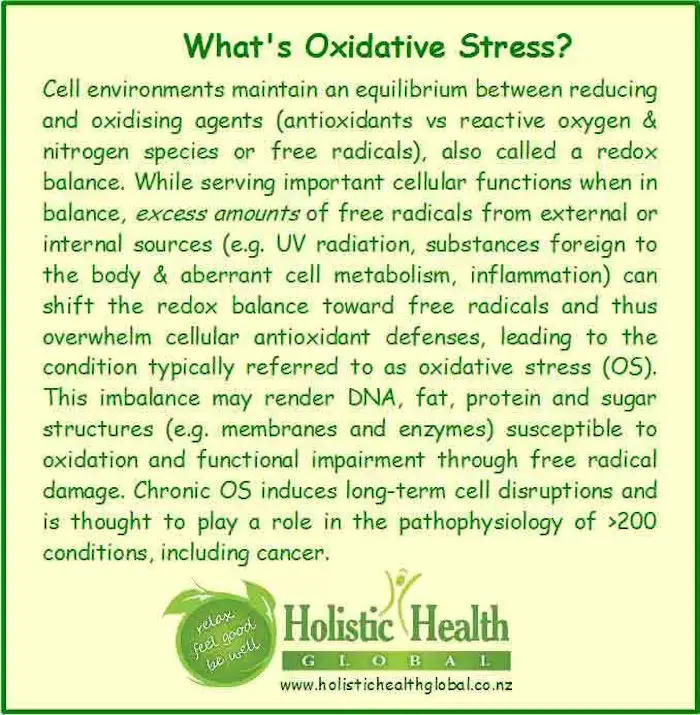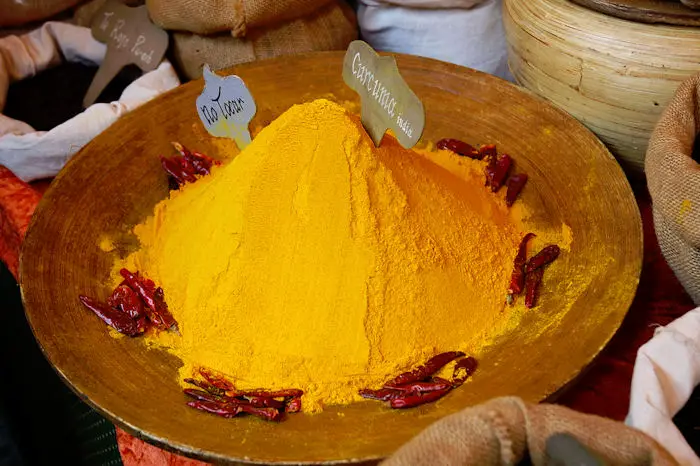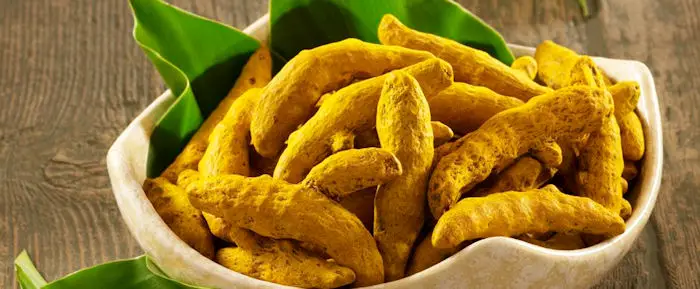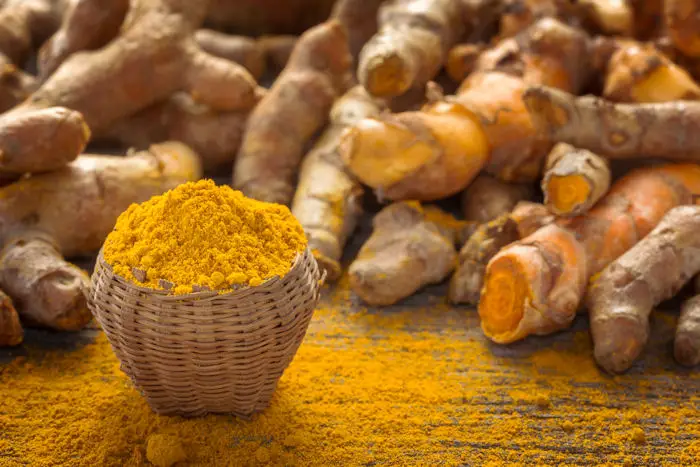By Katrin Geist
Contributing writer for Wake Up World
If there has ever been one plant that “does it all”, turmeric (Curcuma longa), seems the perfect candidate. Its many health benefits and applications fill entire libraries: a search for “turmeric” on Web of Science returned 6.681 hits, and a search for “curcumin”, turmeric’s best known constituent, yielded a whopping 28.122 papers. At point of writing, the Cochrane Library holds 94 publications of controlled clinical trials involving turmeric: whoever says that knowledge of its health benefits is ficticious or anecdotal at best, has accomplished a high degree of ignorance. Even more so since turmeric has been used for culinary and medicinal purposes in Asia for over 6000 years (Hutchins-Wolfbrandt & Mistry 2011) – Western science today only confirms what people have naturally known and practiced for millennia (Goel et al. 2008). In the past two decades, turmeric and curcumin have been extensively studied for their therapeutic benefits as antioxidant, anti-inflammatory, cardioprotective, renoprotective, immunomodulatory, cancer chemopreventive, antidepressant, and neuroprotective agent (Pakfetrat et al. 2014, Chuengsamarn et al. 2012).
What’s In It?
Turmeric belongs to the ginger plant family and is native to southwest India. It contains c. 4-5% curcumin, a polyphenol and strong antioxidant which gives it its bright yellow color. Other turmeric constituents include iron, manganese, potassium, vitamins C & B6, and omega 3 & 6 fatty acids – just to name a few of over 300 compounds identified from this plant (Ravindran et al. 2009, Gupta et al. 2013). Out of all these, curcumin received most investigative attention by far.
Turmeric is also known and used as food additive E100. Funny enough, it is FDA (U.S. Food & Drug Administration) approved as such (FDA website), but not yet as a drug (Ji 2015) – despite all that you’ll read below.
Turmeric’s Many Talents ~ an Overview
- anti-inflammatory action (Bengmark et al. 2009)
- one of the most impressive free radical scavengers
- selectivity: kills cancer cells without harming healthy tissue (Ravindran et al. 2009)
- inhibits human cancer cell lines in vitro* (melanoma, prostate, breast, lung, myeloma, leukemia, neuroblastoma, oral) (Bengmark et al. 2009) *[in vitro = in glass: studying something outside its normal biological context, e.g. human cancer cells in a petri dish or animal proteins in a solution vs in vivo:studying something within the living plant, animal, or human]
- positive synergistic effects with chemotherapy (James et al. 2015, Gupta et al. 2013, Kanai et al. 2010) and radiation treatment (Anand et al. 2008)
- chemopreventive (Goel et al. 2008)
- anti-mutagenic effects (Polasa et al. 1992)
- neuroprotective activity (Pu et al. 2013), including against fluoride toxicity (Sharma et al. 2014) (rodent models)
- ameliorates ischemic stroke (Pu et al. 2013)
- effective antidepressant (Sanmukhani et al. 2013)
- anti-microbial (Goel et al. 2008) & anti-fungal action (Benmark et al. 2009)
- cardiovascular support & thrombosuppressive (Goel et al. 2008)
- tends to decrease the proinsulin/ insulin ratio (Chuengsamarn et al. 2012)
- anti-arthritic (Goel et al. 2008)
- may play a key role in supporting thyroid health (Group 2016)
- liver protective (Goel et al. 2008)
- alcohol detoxification (Sunagawa et al. 2015)
- Goel et al. (2008) offer a referenced list of clinical trials in relation to specific ailments; Bengmark et al. (2009) list diseases and curcumin’s known effects on them.
Turmeric’s Many Talents ~ A Closer Look
Animal studies have demonstrated the potential of curcumin against such maladies as cancer, lung, liver, metabolic, autoimmune, cardiovascular and neurological diseases, and numerous other inflammatory conditions. Curcumin’s clinical efficacy against human biliary disease was first studied in 1937, with remarkably good results for gallbladder inflammation. The most common human diseases where curcumin exhibited positive effects include cardiovascular disease, arthritis, uveitis, cancer, ulcerative proctitis, Crohn’s disease, ulcerative colitis, peptic ulcer, gastric ulcer, idiopathic orbital inflammatory pseudotumor, oral lichen planus, gastric inflammation, vitiligo, psoriasis, acute coronary syndrome, atherosclerosis, diabetes, Dejerine-Sottas disease, diabetic nephropathy, diabetic microangiopathy, lupus nephritis, renal (kidney) conditions, acquired immunodeficiency syndrome, irritable bowel disease, tropical pancreatitis, b-thalassemia, cholecystitis, and chronic bacterial prostatitis (Gupta et al. 2013). I purposefully gave the long – and still incomplete – list to illustrate just what an allrounder turmeric is. To not have it in our kitchen seems rather mad. =)
Anti-inflammatory Agent
Inflammation is the body’s normal response to harmful stimuli and as such appropriate and beneficial. Things only turn problematic when inflammation becomes prolonged and persistent – in other words, chronic. This state does not benefit the organism anymore, but instead fundamentally contributes to degenerative illness. An increasing awareness of chronic inflammation as underlying cause of degenerative disease (e.g. cancer, diabetes, atherosclerosis, rheumatoid arthritis, gastric, ocular, and respiratory diseases) coincides with recognizing turmeric’s potent ability to decrease systemic inflammation (Bengmark et al. 2009). Its powerful free radical scavenging action and rich antioxidant content render turmeric a natural powerhouse to enhance and balance bodily systems.
Cancers
Curcumin’s anticancer activities are well established (Killian et al. 2012). It inhibits the survival and proliferation of almost all types of tumor cells (Ravindran et al. 2009). Specific cancers shown to benefit from curcumin include prostate, skin, brain, blood (leukemia, multiple myeloma), head, neck, breast, lung, bladder, and colorectal cancer, with rarely observed counterindications (Anand et al. 2008, Killian et al. 2012).
Curcumin Mechanisms of Action & Effects
Cancer undergoes three major stages of development: tumor formation, growth, and spread. Often, drugs target any one of these stages. Curcumin, however, can interfere with all three – one reason why some deem it as little prone to resistance development by tumors: curcumin can always take another route (see Ravindran et al. 2009). In animal models, curcumin induced cell death (apoptosis & autophagy) in cancer cells and also inhibited tumor growth, invasion, and in vivo metastasis (Ravindran et al. 2009, Gupta et al. 2013). In vivo animal studies also clearly suggest curcumin’s anticancer potential when administered either alone or in combination with currently employed chemotherapeutic agents or radiation (Goel et al. 2008). This wealth of positive results in animals spurred a host of human studies, including dozens of clinical trials.
Curcumin blocks the expression of growth and metastasis promoting genes (Goel et al. 2008) and so inhibits angiogenesis (connecting the tumor to blood vessels) – a process crucial to tumor growth and spread. It also sensitizes cancer cells to conventional treatment methods (chemotherapy and radiation) (Hutchins-Wolfbrandt & Mistry 2011). One paper reported supplementation with eight grams curcumin per day in combination with the drug gemcitabine as safe and well tolerated in pancreatic cancer patients (Gupta et al. 2013), as were up to two grams curcumin daily in a phase I clinical trial that combined FOLFOX chemotherapy with curcumin (James et al. 2015). Curcumin by itself also gave significantly improved results when tested on patient-derived colorectal liver metastase cells and performed better than FOLFOX and 5-FU (another cancer drug) in some patients (their isolated cells in culture) (James et al. 2015).
Curcumin also decreased PSA levels in men with increased PSA values (PSA: prostate specific antigen, a marker of prostate health). Taking one gram of curcumin daily for a week increased vitamin C and E levels and decreased markers of oxidative stress (see below) in patients with precancerous lesions (Gupta et al. 2013).
Tolerability
Curcumin disrupts and inhibits mechanisms necessary for cancer development and progression in so many ways (Goel et al. 2008) it seems quite superior to any synthetic drug targeting only one pathway – especially when considering its excellent tolerability (non-toxicity). Up to 12g a day have been reported as unproblematic (Goel et al. 2008), whereas conventional cancer drugs are about one hundred times more toxic (Ji 2015a) – not to mention causing any unwanted or adverse effects possibly necessitating another drug to alleviate them. Turmeric and curcumin are very well tolerated by healthy people and patients alike and usually show no adverse effects (Chuengsamarn et al. 2012, Pakfetrat et al. 2014).
Chemoprevention
The term chemoprevention was coined by M.B. Sporn in 1976, who defined it as a “preventive modality in which natural or synthetic agents can be employed to slow, stop, reverse, or prevent the development of cancer” (Park et al. 2013). Curcumin exhibits known chemopreventive effects for breast cancer, stomach cancer, and colorectal cancer – and likely for other types as well. Anti-metastasis effects have been shown for breast cancer and kidney cancer in rats (Anand et al. 2008).
Brain Health
A growing body of evidence implicates free radical toxicity, radical induced mutations and oxidative enzyme impairment in neurodegenerative diseases. All involve significant oxidative damage (see above). In Alzheimer’s Disease, this leads to plaque formation in the brain. A modest dose (24mg/ kg body weight) of curcumin significantly reduced oxidative damage and plaque pathology in mice (Bengmark et al. 2009). A rat model showed similar positive effects (Anand et al. 2008). Furthermore, in a mouse model, curcumin can bind to amyloid proteins in the brain and disrupt the existing plaque commonly seen in Alzheimer’s Disease (Anand et al. 2008), potentially halting or even reversing the disease.
Dietary curcumin improved brain function in aging rats by significantly decreasing reactive oxygen molecules that may otherwise cause oxidative damage to cells (Pu et al. 2013). These authors concluded that curcumin “may be an effective therapeutic strategy to reverse age-related cerebrovascular dysfunction. Curcumin administration may represent a promising lifestyle intervention for preventing age-related cerebrovascular disturbances”.
Research demonstrated curcumin’s neuroprotective effects by showing that dietary curcumin can counteract the outcome of traumatic brain injury on oxidative stress, synaptic plasticity, and cognition. Curry consumption also resulted in better cognitive function in non-demented elderly Asians (Anand et al. 2008).
Curcumin’s neuroprotective role was also shown in a study that exposed mice to water-borne fluoride (120 ppm F for one month), an ion that causes severe neurodegenerative changes in the hippocampus and cerebral cortex areas of mouse brains (Sharma et al. 2014). Supplementation with curcumin significantly reduced fluoride’s toxic effect to near normal levels by augmenting the animal’s antioxidant defense through its free radical scavenging property. This provides evidence for curcumin’s therapeutic benefit in neurodegenerative disease caused by oxidative stress (Sharma et al. 2014).
Overall, curcumin seems to enhance the brain’s ability to avert oxidative stress and looks a promising agent to improve cognitive function and ameliorate neurological disease (Anand et al. 2008).
Depression
Curcumin showed antidepressant activity in mice and alleviates stress-induced depressive behavior by acting on the hypothalamic–pituitary–adrenal axis in rats. A combination of curcumin with other antidepressants synergistically increased serotonin levels and enhanced antidepressant like activity in various animal models.
Turmeric is also a main component of Xiaoyao-san, a remedy used to treat stress and depression-related symptoms in traditional Chinese medicine (Anand et al. 2008). Based on this and results from animal studies, curcumin is formulated and marketed as an antidepressant herbal supplement in the United States (Avea Mood by NutraMedix). Curcumin also inhibits the activity of an enzyme known to play a central role in various psychiatric neurological disorders, including clinical depression and anxiety (Anand et al. 2008).
Sanmukhani et al. (2013) report an exciting study with curcumin tested as antidepressant in people presenting with major depressive disorder (MDD). Their conclusion: ”Ours is the first randomized clinical trial that clearly highlights that curcumin may be an effective and safe agent when used as a modality of treatment in patients of MDD without concurrent suicidal ideation or other psychotic disorders. Curcumin was found to have good efficacy and [a] benign safety profile in patients of depression, [and] it should be further studied as monotherapy and in combination with fluoxetine and other antidepressants […]. […] this study highlights the need for future large-scale clinical trials evaluating the use of this safe and natural dietary botanical as a possible monotherapy in patients with depressive disorders.” Indeed, curcumin performed on a par with fluoxetine (Prozac) in terms of change in the Hamilton Rating Scale for Depression (HAM-D) score from baseline after six weeks of treatment. The antidepressant action of curcumin has been extensively studied in animal models and compares to that of fluoxetine, imipramine, amitriptyline and bupropion. Curcumin increases the brain levels of serotonin, noradrenaline and dopamin (Sanmukhani et al. 2013).
Eye Health
Three different experimental studies reported significant preventive effects of curcumin against cataracts induced by naphthalene, galactose, and selenium (Bengmark et al. 2009).
Anti-mutagenic Effects (Cigarette Smoke & Heating Foods)
Cigarette smoke causes c. 20% of all deaths. It contains thousands of compounds, with c. 100 known carcinogens, co-carcinogens, mutagens and/or tumor promoters. Each puff of smoke contains over 10 trillion free radicals. Smokers show significantly reduced blood antioxidant levels (Bengmark at al. 2009) and excrete high amounts of tobacco derived mutagens in urine (the latter also pertaining to passive smokers) (Polasa et al. 1992).
Research showed that: “Curcumin is able to inhibit the mutagenicity of cigarette smoke condensate and tobacco extract, which are aetiological [causative] factors in oropharyngeal [throat] cancer in India. […] curcumin is an effective antimutagen in vitro against several environmental and standard mutagens/ carcinogens that require metabolic activation. Widespread use of turmeric may afford protection against some environmental mutagens/ carcinogens” (Nagabhushan et al. 1987). Indeed, dietary turmeric (1.5 g/day) significantly decreased the amount of mutagens excreted in the urine of smokers (Polasa et al. 1992).
Cooking foods can lead to mutagen formation from food constituents reacting to heat. In one study, turmeric and curcumin blocked the generation and activation of food derived mutagenic substances. Turmeric garlic barbecue sauce also inhibited the formation of beef barbecue mutagens (Kolpe et al. 2002).
Cardiovascular Support
Curcumin has a strong capacity to prevent lipid peroxidation, stabilize cell membranes, inhibit proliferation of vascular smooth muscle cells, and inhibit platelet aggregation – all important factors in atherosclerosis development (Bengmark et al. 2009).
In a human study, ten healthy volunteers received 500mg of curcumin daily for seven days. This simple, completely non-toxic measure led to a significant decrease in serum lipid peroxides (33%), an increase in serum HDL* cholesterol (29%), and a nearly 12% decrease in total serum cholesterol. These findings led researchers to suggest a potential chemopreventive role for curcumin in arterial diseases (Goel et al. 2008). *[HDL: high-density lipoprotein]. This also sits well with curcumin’s known anti-thrombotic properties (Polasa et al. 1992).
Curcumin has also been shown to improve heart function in rabbits (Gupta et al. 2013).
Diabetes & Metabolic Syndrome
Curcumin positively influences blood sugar levels in diabetics (Nagabhushan et al. 1987). In a more recent study examining the possible use of curcumin as a preventive measure to keep prediabetic people from progressing to type 2 diabetes, researchers concluded: “Because of its benefits and safety, we propose that curcumin extract may be used for an intervention therapy for the prediabetic population” (Chuengsamarn et al. 2012). In other words, curcumin worked extremely well in helping people to prevent onset of type 2 diabetes by simply consuming 250mg of curcumin extract daily. How many people thus acting prevented developing type 2 diabetes? All of them – 100%.
Going on from that, a six months curcumin intervention trial with type 2 diabetes patients lowered their atherogenic risk. The curcumin extract also helped to improve relevant metabolic profiles in this high-risk population (Chuengsamarn et al. 2014).
Another study examined the efficacy of a standardized preparation of curcuminoids against various oxidative stress and inflammatory markers in patients with type 2 diabetes. Curcumin significantly improved endothelial function and reduced oxidative stress and inflammatory markers in these patients (Gupta et al. 2013).
A combination of turmeric and black seeds improved lipid profiles along with blood glucose and C-reactive protein levels after eight weeks of treatment in patients at risk of developing Metabolic Syndrome (often a precondition of diabetes and cardiovascular disease). Researchers of this clinical trial therefore recommend using black seeds and turmeric, together with life style changes, to prevent future complications and halt progression of Metabolic Syndrome symptoms (Amin et al. 2014).
Gallstones
Research suggests that curcumin can effectively induce the gall bladder to empty, thereby reducing the risk of gallstone formation, and ultimately gall bladder cancer (Goel et al. 2008). Learn how you can easily remove gallstones while you’re asymptomatic and without a surgeon’s knife here.
Alcohol Toxicity
In a rat model, curcumin supplementation (80 mg/kg body weight) improved the degree of pathological changes observed from chronic alcohol consumption. Animals showed significantly improved values for cholesterol, phospholipids, and free fatty acids in brain tissue after receiving curcumin treatment (Bengmark et al. 2009).
Gastrointestinal Diseases
Curcumin effectively reduced growth of 19 different Helicobacter pylori strains, including five associated with premalignant and malignant lesions. It also inhibited infection and inflammation of gastric mucosal cells (Bengmark et al. 2009).
Curcumin improved clinical outcome in patients with tropical pancreatitis and proved therapeutic in patients with inflammatory bowel disease (namely Crohn’s disease and ulcerative colitis) (Goel et al. 2008).
Turmeric also significantly improved Irritable Bowel Syndrome (IBS) symptoms in a pilot study with 207 healthy adults taking turmeric extract daily for eight weeks (Goel et al. 2008).
Antirheumatic Activity
In a clinical trial, curcumin exerted an antirheumatic activity comparable to that of phenylbutazone. It was well tolerated, with no side effects (Goel et al. 2008).
Take it Right! How Much? How Best? When Not?
Consumption varies between populations, and it’s interesting to note that regions where turmeric is a common food ingredient show much lower cancer rates (Bengmark et al. 2009). The traditional Nepali dal recipe combines turmeric with ghee, black pepper, and other spices, as do curries and other dishes in India (Hutchins-Wolfbrandt & Mistry 2011). Turmeric is used as fresh root and dried powder. Note the addition of fat and pepper: both increase the absorption of turmeric in the small intestine – an important detail for increasing bioavailability and deriving most benefit.
Diet surveys in India show the use of turmeric averages around 0.24 g/person/day among high-income households, and around 0.49 g/person/day among low-income households. In rural areas of India, consumption is around 0.73 g/person/day (Krishnaswamy 2006), with some estimates as high as 4 g/person/day, which would supply approximately 80-200 mg of curcumin (Tapsell et al. 2006). In Nepal, the consumption rate of turmeric ranges between 0.5 and 1.5 g/person/day (Eigner & Scholz 1999).
Going from the studies cited above, a common therapeutic dose is 400-600 mg curcumin 3x/ day, corresponding to up to 60 g fresh turmeric root or about 15 g turmeric powder (turmeric usually contains 4-5% curcumin) (Bengmark et al. 2009).
Given all this, it seems about a teaspoon of turmeric a day would suffice for use as a preventive measure. Remember to combine with fat and/ or black pepper for better intestinal absorption and thus subsequent positive action in your body.
Turmeric is generally viewed as safe. The only situations I came across to not take turmeric or curcuminsupplements is pregnancy. It is still fine to use the natural spice, however. That seems the consensus. The other case pertains to surgery. Turmeric may act as a blood thinner, so it’s best to stop supplementation prior to any surgery. When in doubt, discuss taking supplements with your health care provider first.
Turmeric or Curcumin?
Personally, I prefer the whole over its isolated part, and some researchers share this view (Gupta et al. 2013) – it may depend on the individual situation which form is appropriate for you. I tend to use as whole a food as I can to keep its holistic aspect. Turmeric root or powder works just fine for me, especially because other components of turmeric also confer health benefits (Hucklenbroich et al. 2014). If you’d like to ensure regular, consistent, more concentrated and convenient intake, this organic supplement may do the trick, too. It’s also practical during the hotter months, with naturally fewer curries and soups on the menu.
Conclusion
As shown here and in a myriad of other articles, curcumin modulates multiple cellular signaling pathways and interacts with numerous molecular targets in the body to affect a host of positive outcomes. Its beneficial activities for human health are clear. Despite shown efficacy in numerous clinical trials, with results equal to or exceeding those of approved drugs in some instances, curcumin has not yet been approved for the treatment of any human diseases (Gupta 2013, Ji 2015). Many plant-based products accomplish multi-targeting naturally and are inexpensive and safe compared to synthetic drugs. However, plants cannot (yet?) be patented – pharmaceutical companies do not usually receive intellectual property rights to plant-based products – only their derivatives. Thus, development of plant-based anticancer therapies is not prioritized (Anand et al. 2008). And in the case of turmeric, perhaps it needn’t be – your local store offers ample supplies and supplements formulated to contain higher amounts also abound.
One study concluded thus: “Furthermore, its ability to kill tumor cells and not normal cells makes curcumin an attractive candidate for drug development” (Ravindran et al. 2009).
I would rewrite it a little: Its ability to support healthy cells and selectively kill tumor cells renders turmeric an attractive candidate for drug development your kitchen shelf. =)
And Now: Turmeric Milk, Anyone?

- 2 cups unsweetened organic almond milk
- 1 tsp ground turmeric or 1 tbsp fresh turmeric
- ½ tsp ground cinnamon
- ¼ tsp ground ginger
- ½ tsp vanilla extract
- 1 tsp coconut oil
- 1-2 tsp maple syrup (honey works too)
- ice cubes, for serving
- ground cinnamon for serving
- black pepper for serving
- In a pot, heat almond milk, turmeric, cinnamon, ginger, vanilla, coconut oil and maple syrup until it comes to a boil.
- Let simmer for 2-3 minutes. Remove from heat. That’s your hot drink version ready to enjoy.
- For the iced drink, refrigerate above mix for a few hours or overnight. Mix well.
- Pour over a glass of ice and top with ground cinnamon and black pepper. Yum!
In lieu of almond milk, you can also use rice or coconut milk; adding a date as sweetener (instead of syrup or honey) also works well. Play with the ingredients to suit your palate. Some add banana and blend it all up (cold) – the possibilities are endlessly delicious. =)
Source of this recipe and many more.
Please note that above article is offered for information purposes only and does not constitute medical advice in any way.
For more articles like this, sign up to Holistic Health Global’s monthly Healthy Living Newsletter or like HHG on Facebook! You can also connect on YouTube and online at HolisticHealthGlobal.co.nz
About the author:
 Katrin Geist loves exploring the mysteries of life. Initially doing so as a biologist, she now devotes her time to helping people regain and maintain their wellbeing through Reconnective Healing and wellbeing coaching. Biophysics taught her the importance and far reaching implications of a truly holistic approach to wellbeing, and to life at large. More and more, she begins to understand how energy, frequency, and information shape our lives – knowingly or not.
Katrin Geist loves exploring the mysteries of life. Initially doing so as a biologist, she now devotes her time to helping people regain and maintain their wellbeing through Reconnective Healing and wellbeing coaching. Biophysics taught her the importance and far reaching implications of a truly holistic approach to wellbeing, and to life at large. More and more, she begins to understand how energy, frequency, and information shape our lives – knowingly or not.
Katrin holds a BA from the University of Montana, U.S.A. and an MSc in biology from Berlin University (FU). This science background enables her to communicate scientific subjects in an accessible way, so that everyone can benefit from information otherwise often confined to technical experts.
Katrin has held international wellbeing clinics in several countries and currently works from her New Zealand office in Dunedin. She feel privileged to serve in this capacity and invites you to experience something different. Take back the reins of your health and discover more!
To contact Katrin for personal or remote sessions and to invite her for a seminar or presentation, please call or email her. You can contact Katrin via Facebook • Email • Website • or telephone 0064 (0)21 026 95 806 (NZ mobile).
For more articles like this, sign up to Holistic Health Global’s monthly Healthy Living Newsletter or like HHG on Facebook! You can also connect on YouTube and online at HolisticHealthGlobal.co.nz
Article sources:
Scientific papers:
- Amin et al. (2015). Clinical efficacy of the co-administration of Turmeric and Black seeds (Kalongi) in metabolic syndrome – A double blind randomized controlled trial – TAK-MetS trial.
- Anand et al. (2008). Curcumin and cancer: An ‘‘old-age” disease with an ‘‘age-old”solution
- Bengmark S, MD Mesa and A Gil (2009). Plant-derived health – the effects of turmeric and curcuminoids
- Chuengsamarn et al. (2012). Curcumin Extract for Prevention of Type 2 Diabetes
- Chuengsamarn et al. (2014). Reduction of atherogenic risk in patients with type 2 diabetes by curcuminoid extract: a randomized controlled trial
- Goel A, Kunnumakkara AB and BB Aggarwal (2008). Curcumin as “Curecumin”: From kitchen to clinic
- Group E. (2016). Can Turmeric Support Thyroid Health?
- Gupta SC, Kismali G and BB Aggarwal (2013). Curcumin, a Component of Turmeric: From Farm to Pharmacy
- Hucklenbroich et al. (2014). Aromatic-turmerone induces neural stem cell proliferation in vitro and in vivo
- Hutchins-Wolfbrandt A and AM Mistry (2011). Dietary Turmeric Potentially Reduces the Risk of Cancer
- James et al. (2015). Curcumin inhibits cancer stem cell phenotypes in ex vivo models of colorectal liver metastases, and is clinically safe and tolerable in combination with FOLFOX chemotherapy
- Jawa A, Jawad A, Riaz SH, et al. Turmeric use is associated with reduced goitrogenesis: Thyroid disorder prevalence in Pakistan (THYPAK) study.
- Ji S (2015). Why is Turmeric Still Not FDA Approved?
- Ji S (2015a). Better than chemo: turmeric kills cancer, not patients
- Jurenka JS. Anti-inflammatory properties of curcumin, a major constituent of Curcuma longa: a review of preclinical and clinical research. Altern Med Rev. 2009 Jun;14(2):141-53.
- Kanai et al. (2010). A phase I/II study of gemcitabine-based chemotherapy plus curcumin for patients with gemcitabine-resistant pancreatic cancer.
- Killian et al. (2012). Curcumin Inhibits Prostate Cancer Metastasis in vivo by Targeting the Inflammatory Cytokines CXCL1 and -2
- Kolpe et al. (2002). Turmeric and curcumin prevents the formation of mutagenic Maillard reaction products.
- Lee et al. (2016). Turmeric improves post-prandial working memory in pre-diabetes independent of insulin.
- Nagabhushan M, Amonkar AJ and SV Bhide (1987). IN VITRO ANTIMUTAGENICITY OF CURCUMIN AGAINST ENVIRONMENTAL MUTAGENS
- Panahi et al. (2015). Antioxidant and anti-inflammatory effects of curcuminoid-piperine combination in subjects with metabolic syndrome: A randomized controlled trial and an updated meta-analysis
- Pakfretat et al. (2014). Role of turmeric in oxidative modulation in end-stage renal disease patients
- Polasa et al. (1992). Effect of turmeric on urinary mutagens in smokers
- Pu et al. (2013). Dietary Curcumin Ameliorates Aging-Related Cerebrovascular Dysfunction through the AMPK/Uncoupling Protein 2 Pathway
- Ravindran et al. (2009). Curcumin and Cancer Cells: How Many Ways Can Curry Kill Tumor Cells Selectively?
- Sanmukhani et al. (2013). Efficacy and Safety of Curcumin in Major Depressive Disorder: A Randomized Controlled Trial
- Sharma et al. (2014). Curcumin attenuates neurotoxicity induced by fluoride: An in vivo evidence
- Sunagawa et al. (2015). Colloidal Submicron-Particle Curcumin Exhibits High Absorption Efficiency—A Double-Blind, 3-Way Crossover Study
Note: Some of the links above use the magnificent sci-hub.io website. If you do get a “Server not found” error after clicking on the reference link, substitute .io with .bz or .cc in the browser’s address bar– this usually does the trick. =)
Websites & Web Articles
- http://consciouslifenews.com/drinking-orange-tea-detox-liver/1191814/
- http://complete-health-and-happiness.com/smokers-how-to-make-a-miracle-elixir-to-clean-your-lungs/
- http://www.greenmedinfo.com/blog/2000-reasons-it-unethical-turmeric-not-fda-approved
- http://www.greenmedinfo.com/substance/curcumin
- http://themindunleashed.org/2014/06/science-confirms-turmeric-effective-14-drugs.html
- https://wakeup-world.com/2015/08/19/is-the-cure-for-diabetes-a-humble-root-turmeric/
- http://www.treehugger.com/green-food/7-homemade-turmeric-teas-and-elixirs.html
- http://www.healthdiaries.com/eatthis/20-health-benefits-of-turmeric.html
- http://www.fda.gov/ForIndustry/ColorAdditives/ColorAdditiveInventories/ucm115641.htm
- http://articles.mercola.com/sites/articles/archive/2011/04/26/the-spice-that-actually-doubles-as-a-powerful-antiinflammatory.aspx
- http://www.wakingtimes.com/2015/09/16/better-than-chemo-turmeric-kills-cancer-not-patients/
Previous articles by Katrin Geist:
- Canned – Do Energy Drinks Truly Give Us Wings Or Is It All Real Bull?
- Navigating the Plastic Jungle – Understanding What’s What PLUS Easy Ways to Adjust Your Plastic Use
- The FAT Facts: Butter vs Margarine
- The Power of Convictions and How They Shape Our Lives
- 10 Significant Reasons Why Regularly Drinking Green Tea Is An Awesome Healthy Living Habit!
- Truly Healing From Cancer and Preventing It Altogether
- How to Lose Your Mind and Create a New One
- Research Shows Promising Effects Treating Advanced Cancer with Light Frequencies
- Depression & Anxiety: Discover 3 Powerful, Drug-Free Ways that Help Thousands, Naturally
- The Power of Suggestion – Are You Asking the Right Questions?

If you've ever found value in our articles, we'd greatly appreciate your support by purchasing Mindful Meditation Techniques for Kids - A Practical Guide for Adults to Empower Kids with the Gift of Inner Peace and Resilience for Life.
In the spirit of mindfulness, we encourage you to choose the paperback version. Delve into its pages away from screen glare and notifications, allowing yourself to fully immerse in the transformative practices within. The physical book enriches the learning process and serves as a tangible commitment to mindfulness, easily shared among family and friends.
Over the past few years, Wake Up World has faced significant online censorship, impacting our financial ability to stay online. Instead of soliciting donations, we're exploring win-win solutions with our readers to remain financially viable. Moving into book publishing, we hope to secure ongoing funds to continue our mission. With over 8,500 articles published in the past 13 years, we are committed to keeping our content free and accessible to everyone, without resorting to a paywall.

